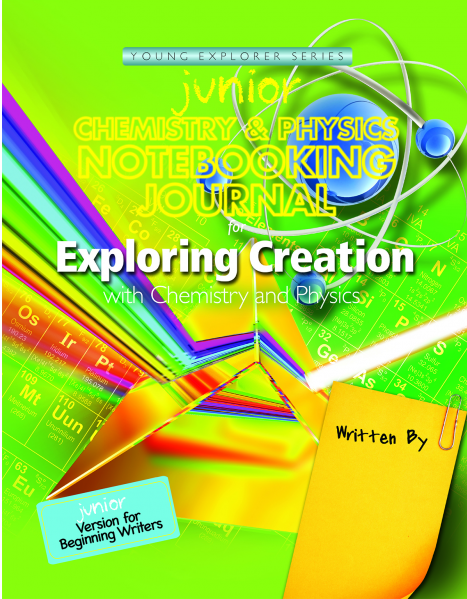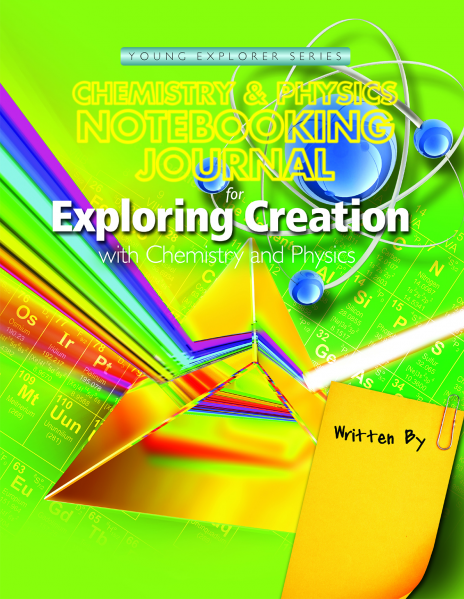We were very excited to be given the chance to review Apologia Educational Ministries homeschool science curriculum for grades K-6, specifically:
- Exploring Creation with Chemistry and Physics (Book) $39
- Exploring Creation with Chemistry and Physics Notebooking Journal $24
- Exploring Creation with Chemistry and Physics Junior Notebooking Journal $24

Exploring Creation with Chemistry and Physics (Book) is the main textbook and can be used again and again. It is 253 pages, plus a supply list (for experiments), and an answer key. Written by Jeannie Fulbright, this is part of the Apologia Young Explorer Series (grades K-6), which also includes:

- Astronomy
- Botany
- Human Anatomy and Physiology
- Zoology 1, 2, and 3
This hardbound text is broken into 14 lessons, and can be easily done in one school year at a pace of 1 lesson per two weeks. The lessons cover:
- Chemistry and Physics Matter
- Moving Matter
- Building Blocks of Creation (atoms)
- Compound Chemistry
- Multitude of Mixtures
- Mechanics in Motion
- Dynamics of Motion
- Work in the World
- Sound of Energy
- Light of the World
- Thermal Energy
- Electrifying Our World
- Mysterious Magnetism
- Simple Machines
The lessons range from 14-18 pages each and include many pictures and as many as 10 "Try this" experiments each. This means you could do a "Try This" nearly every day if you were following the two weeks per lesson pacing. Most of the experiments were using everyday household materials, so I didn't have to purchase any expensive kits. The lesson ends with a summary page, including questions and follow up activities.
One of the best parts of this text is the Christian worldview, but the conversational style is a close second. Jeannie Fulbright has a gift for writing in a way that kids want to listen to. She often explains complex processes in simple but entertaining narratives. For example: in the second Lesson, speaking of the states of matter and the energy of the molecules, she relates it to children with energy and wiggles, bouncing about a room. My 6-year-old really grabbed onto that concept and talks about it often.
- Vocabulary Crosswords
- Fascinating Facts
- Flap Books
- Copywork
- Test It Out
- Fact Wheels
- Tuck-in Envelopes
- Various Projects and Experiments
- Layered Books
- Field Trip Sheets
- Review section of narrative questions titled "What Do You Remember?"
- And a Final Review consisting of 50 review questions.
 Of course my favorite feature in the notebooking journal would have to be the lesson plans in the front of the book. This gives reading assignments for the text as well as matches up the Notebooking Journal pages to those same concepts. It breaks each lesson down into two weeks with two days of assignments per week. This homeschool science journal really expands on the text and helps with my more tactile students. This journal is ideal for upper elementary, grades 4-6.
Of course my favorite feature in the notebooking journal would have to be the lesson plans in the front of the book. This gives reading assignments for the text as well as matches up the Notebooking Journal pages to those same concepts. It breaks each lesson down into two weeks with two days of assignments per week. This homeschool science journal really expands on the text and helps with my more tactile students. This journal is ideal for upper elementary, grades 4-6.
The Exploring Creation with Chemistry and Physics Junior Notebooking Journal is just like the regular notebooking journal, except geared for younger children who have not mastered handwriting. Ideal for grades K through 3rd (lower elementary grades), it has all of the same hands on projects as the regular journal, but exchanges coloring pages for some of the more intensive journaling pages. The writing lines are larger, and the copywork is shorter. It worked really well for my two youngest to be working in this journal, while my two oldest used the regular journal.
How we used this:
Because we have a 4 day school week, we chose to do science every day. I opened up the lesson plans in the front of the notebooking journals and divided the "Day 1" and "Day 2" assignments into two parts, and made the same week into 4 smaller assignments. We would gather together, and my two oldest took turns using the regular notebooking journal, while my two youngest shared the junior notebooking journal. After reading the assigned pages and filling in the journals, we took the time to try out and discuss some of the "Try This!" experiments. They were easy to do, and often used supplies we already had on hand.
 Jeannie Fulbright's writing style was in a conversational upbeat tone, so was easy to read aloud to my children. Often my youngest (age 6) wasn't as interested in the journal, so would sit with me as I read and looked at the colorful pictures in the text. My oldest struggles with writing, but excelled at the crosswords. My second-born LOVES writing, so took her turn with the copywork pages. My third child, the 7 year old, liked the junior notebooking journal the best, so would color or cut and paste while I was reading. Gathered around like that, everyone had something to keep their attention. It was easy to get through the lesson, and to stop and discuss the concepts.
Jeannie Fulbright's writing style was in a conversational upbeat tone, so was easy to read aloud to my children. Often my youngest (age 6) wasn't as interested in the journal, so would sit with me as I read and looked at the colorful pictures in the text. My oldest struggles with writing, but excelled at the crosswords. My second-born LOVES writing, so took her turn with the copywork pages. My third child, the 7 year old, liked the junior notebooking journal the best, so would color or cut and paste while I was reading. Gathered around like that, everyone had something to keep their attention. It was easy to get through the lesson, and to stop and discuss the concepts.
Throughout the text in the chapter, the vocabulary words were bolded, so when the kids needed to define them for the vocabulary crosswords, they could find them used in context. We also used the vocabulary word lists as spelling lists, as a way to re-enforce them.
One of the things I noticed about this text, vs. the other Apologia science curriculum we had tried, was that there are quite a few more pictures, engaging graphics, and "Try This!" boxes. As I mentioned before, you could do one of them every day and not run out. The engaging pictures made it easier to keep the kids interested in the text as we read. This was a big improvement over our previous course.
Also, I had said I couldn't possibly use the Zoology book without the notebooking journal, but this one was different. The text alone had enough engaging and entertaining activities, that I think the notebookig journal could be completely optional, if you don't have a real need for your tactile child to have busy hands while you read.
Bottom Line:
We loved this, probably more than any science we've yet tried. I would probably buy the text alone, although the course schedule in the front of the notebooking journal was super helpful. Doing science as a family was a wonderful experience, and I could tell this program was designed with homeschool families at the forefront of the author's intentions. Everyone from grades K thought 6th at our house learned a lot (and also the teacher!) from this curriculum, and it was not difficult to adapt to all ages. The journals go very well with the text, and worked very well for us to keep everyone involved. We were blessed to try it out.
Be sure you check out all the other reviews of this homeschool science resource, by visiting the crew blog:


*Prices and links are accurate at the time this is published, and are subject to change
©2012-2013 Loving and Learning on the High Plains. All rights reserved. All text, photographs, artwork, and other content may not be reproduced or transmitted in any form without the written consent of the author. http://www.homeschoolhighplains.blogspot.com



No comments:
Post a Comment
I always wonder if my words are encouraging to you, so please leave a comment!